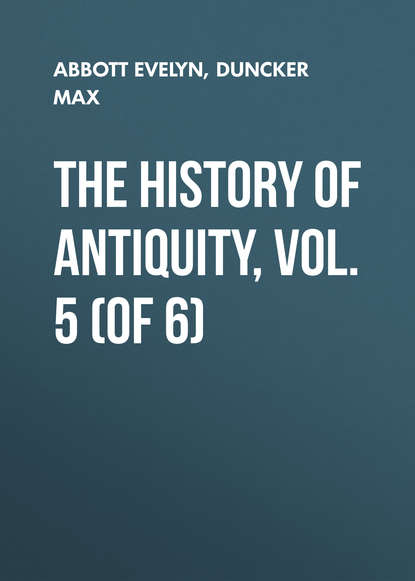По всем вопросам обращайтесь на: info@litportal.ru
(©) 2003-2024.
✖
The History of Antiquity, Vol. 5 (of 6)
Настройки чтения
Размер шрифта
Высота строк
Поля
480
Herod. 1, 72. In Xenophon, who represents Astyages as reigning before Cyaxares, Astyages had subjugated the king of Armenia; the rebellion of this king was afterwards repressed by Cyaxares. "Cyri instit." 3, 1, 6 ff.
481
Vol. III. 287, 438. Even after the discussions of Gelzer ("Rheinisches Museum," 1875, s. 264 ff.) on the date of the eclipse, I believe that Oltmann and Bailly's calculation may hold good for it, until it is proved astronomically that in the year 610 B.C. an eclipse of the sun would not have been visible in Asia Minor. If this were proved, Herodotus' dates for Cyaxares, who not only in his work but on the evidence of the inscription of Behistun, was the founder of the Median empire, would have to be thrown back more than half a century, which the date of Cyrus does not allow. To assume a confusion of Cyaxares with Astyages in Herodotus, is impossible, for Cyaxares is twice expressly mentioned (1, 74, and 103), and moreover Astyages is spoken of as the son of Cyaxares to whom Aryanis was married. Nor can I regard it as finally proved that the double capture of Sardis rests simply on Callisthenes, and a deduction from Strabo. Gelzer agrees that the incursions of the Cimmerians into Asia Minor and their establishment in Cappadocia must be placed at the least before the year 705 B.C. ("Z. Aegypt. Sprache," 1875, s. 18); the devastation of Phrygia by the Cimmerians he puts in the year 696 or 676 B.C. According to the dates of Eusebius Midas (the husband of Damodike) began to reign in Olymp. 10, 3 = 738, and took his own life in Ol. 21, 2 = 695 (Euseb. ed. Schöne, 2, 82, 85); his reign extended therefore from 738 to 695 B.C. Hence the devastation of Phrygia by the Cimmerians must have taken place in the year 695. If they were masters of Phrygia at this date, it is not easy to see why these successes did not carry them on into Lydia. As a fact, this is far from improbable; and if the image at Nymsi is their work, they would not have had any time for it in 630 B.C., for that incursion was merely a "plundering raid," and the change in the dynasty of Lydia, the accession of Gyges in the year 689 B.C. (Vol. III. 416), seems to me to point to some previous violent change. Besides, Strabo's words, p. 61, and p. 647, are plain and conclusive enough, so that I see no reason to attach much weight to the interpretation of the passage, p. 627. Cf. Cæsar, "Ind. lect. Marb. Sem. aestivum," 1876.
482
Vol. III. 284 ff., 291.
483
Diod. 2, 34; Nicol. Damasc. fragm. 66.
484
Nicol. Damasc. fragm. 9, 10, ed. Müller; Diod. 2, 33; Ctes. Fragm. 52, ed. Müller.
485
Roxane and Roxanace are both formed from the old Bactrian raokshna. Müllenhoff, "Monatsberichte Berl. Akadem." 1866, s. 562.
486
Ctes. Fragm. 25-28, ed. Müller; Nic. Damasc. fragm. 12 ed. Müller.
487
Oppert gives the form of the second version as Çakuka Iskunka.
488
Choerilus in Strabo, p. 303; Herod. 3, 93; 7, 64; 9, 71; Ptolem. 6, 13; Curtius, 7, 4, 6; Arrian, "Anab." 3, 13; Cf. Plut. "Crassus," 24.
489
Nicol. Damasc. fragm. 66, ed. Müller.
490
"Ind." 1, 1.
491
Diod. 2, 13; 17, 110; Strabo, p. 127.
492
Diod. 2, 13.
493
Herod. 1, 98, 99.
494
Polyb. 10, 27.
495
17, 110.
496
"Mans. Parth." c. 6.
497
Judith, i. 2-4. On the date of the composition of this book, cf. Volkmar. "Rheinisches Museum," 12, 481. In any case it dates from the end of the first or the second century of our reckoning.
498
Thuc. 2, 13, and the Scholia.
499
Diod. 2, 8.
500
Diod. 17, 71.
501
Hence I see no reason for connecting the colours of the turrets with the Babylonian star-worship. The only fact in favour of this is the black of the second wall; but as the highest turrets exhibited the two most precious metals, the others may have received the colours of the remaining five, over all of which Kshathra vairya presided, and in the order of the Avesta in which silver and copper follow gold, while iron and steel end the list. It can hardly be proved that Babylonian star-worship had a decisive influence among the Medes at the time of Cyaxares. Isaiah xiii. 17 might be quoted against the wealth of Ecbatana, but this passage only gives the idea of the writer that the Medes would not be bought off by Babylonian money, and abandons the destruction of Babylon for the sake of gold. Setting this aside, the episodes quoted above show that at the time of Astyages men could regret the loss of ancient simplicity in Media, and extol it against the gold which had come from Nineveh to Ecbatana, and against the gold of Babylon (p. 301). The nation may also have remained in simple habits of life however brilliant the royal citadel may have been. Yet it has already been observed in the text that at the time of Cyaxares and Astyages the upper classes lived in wealth and comfort.
502
Diod. 17, 66, 71; 19, 48; Strabo, p. 731; Plut. "Alex." 72.
503
Strabo, p. 523.
504
Burnouf, "Commentaire sur le Yaçna," p. 251.










